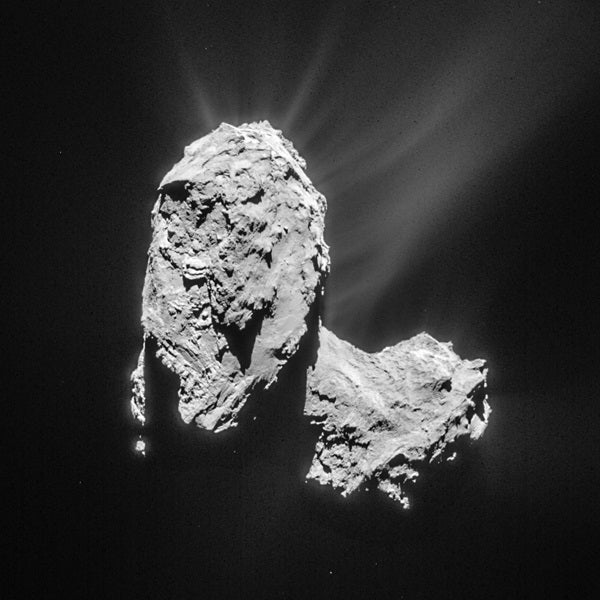Professor Konstantinos P. Giapis and postdoctoral researcher Yunxi Yao have published their results in Nature Communications. In their study, they explain the production of O2 on the comet based on a mechanism seen in their chemical engineering research. In the lab, Giapis and Yao focus on the results of collisions between charged particles, called ions, and the surfaces of semiconducting materials. Their goal is to develop better computer chips with faster response times and increased memory capacity for next-generation electronics. But collisions of this type can also take place on the surface of comets as they near the Sun, providing the source of the O2 measured in comet 67P’s atmosphere as well.
“After looking at measurements made on Rosetta’s comet, in particular regarding the energies of the water molecules hitting the comet, it all clicked,” says Giapis in a press release announcing the study. “What I’ve been studying for years is happening right here on this comet.”
How does such a reaction happen? As a comet nears the Sun, its temperature rises as increased radiation strikes the surface. This causes ices on and near the surface to vaporize, throwing off molecules that include water vapor. These molecules encounter ultraviolet radiation from the Sun, which is comprised of highly energetic particles, and lose electrons in the process, becoming charged ions (like those in Giapis’ lab). These ions are blown back onto the comet by the solar wind, where they encounter materials such as rust, sand, and ice that contain oxygen bound within them. The collision causes the ionized molecules to pick up additional oxygen atoms, resulting in the formation of O2.
Previously, the only explanation for the O2 found in the comet’s atmosphere was primordial O2 locked away as ices since the formation of the solar system, roughly 4.6 billion years ago. This explanation was problematic, however, as astronomers believed that even as ice, O2 should have reacted with other chemicals over the comet’s history, rather than remain pristine.
Giapis and Yao’s explanation fits much better with the emerging picture Rosetta has painted of comets as dynamic systems. Instead of unlocking primordial O2, reactions between the comet and the increasing sunlight create new O2 in real time. “We have shown experimentally that it is possible to form molecular oxygen dynamically on the surface of materials similar to those found on the comet,” says Yao.
Because, as Giapis says, “[a]ll necessary conditions for such reactions exist on comet 67P,” this finding has far-reaching implications for not only our understanding of cometary chemistry in our own solar system, but also the production and presence of O2 on, say, extrasolar planets. If life is not a likely requirement for the presence of O2, it will affect the ways in which astronomers search for potentially habitable — or potentially currently inhabited — exoplanets in the future.
The study also highlights the benefits of applying science across varying disciplines, showing that mechanisms studied in specialized labs can have amazing applications beyond Earth-based technology.










